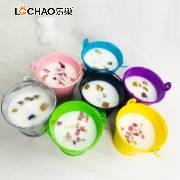To determine whether an aromatherapy candle has artificial fragrance, it is necessary to combine sensory observation, ingredient analysis, and user experience. Here are some practical identification methods for reference:
1. Check the ingredient label
-Natural ingredient label: Natural aromatherapy candles usually clearly mark the ingredients, such as "100% natural plant essential oil" (Essential Oil), beeswax, soy wax, etc. If "Fragrance Oil", "Perfume" or "Artificial Fragrance" appears in the ingredient list, it contains artificial fragrance.
-Beware of vague statements: If it is only marked with "fragrance" without specific instructions, it may contain artificial ingredients.
2. Smell the difference
-Odor characteristics:
Natural essential oils: The fragrance is rich in layers and may have subtle changes (such as citrus is fresh but evaporates quickly, and woody notes are more persistent), close to the smell of the plant itself.
Artificial fragrance: The smell is single, strong, or even pungent (such as too sweet or chemical), and long-term smell may cause dizziness.
Diffusion speed: The fragrance of artificial fragrances may diffuse quickly after being ignited, while the fragrance of natural essential oils is released more slowly.
3. Observe the burning performance
- Smoke and residue: Artificial fragrance candles may produce black smoke or pungent odors when burning, and the wax pool may feel greasy after cooling; natural candles have less smoke and cleaner residues.
- Fragrance persistence: The fragrance of artificial fragrances may be very strong before burning, while the fragrance of natural essential oils is often not obvious until heated.
4. Price and brand credibility
- Cost difference: Natural plant essential oils are more expensive. If the price of candles is significantly lower than similar products, they may contain artificial fragrances.
- Certification mark: Check whether there is organic certification (such as USDA Organic, Ecocert) or pure natural logo, but be careful of the "green washing" marketing trap.
5. Testing method
- Cold sniff test: When not ignited, the fragrance of natural essential oil candles is lighter, and artificial fragrances may directly emit strong fragrance.
- Burning test: After burning, the scent of artificial fragrances may become monotonous or chemical, while natural fragrances will be softer and more natural.
6. Other clues
- Wax-based materials: Natural wax-based materials such as soy wax and beeswax are more likely to be paired with natural essential oils, and paraffin candles (especially cheap ones) often use artificial fragrances.
-*Allergic reactions: If sensitive people experience headaches and sore throats after use, it may be caused by artificial fragrances.
Summary suggestions:
- Give priority to transparent brands: Choose brands that clearly label ingredients and provide the source of essential oils.
- Sample test: Smell or purchase samples before buying to observe the feeling after burning.
- DIY comparison: Try to make candles with natural essential oils to familiarize yourself with the characteristics of natural fragrances for easy comparison.
Artificial fragrances are not completely harmful, but natural essential oils are generally safer and have aromatherapy value. You can weigh your choices based on your needs and budget.





